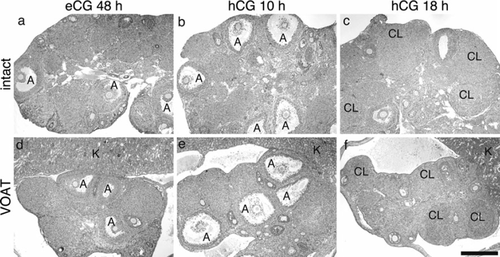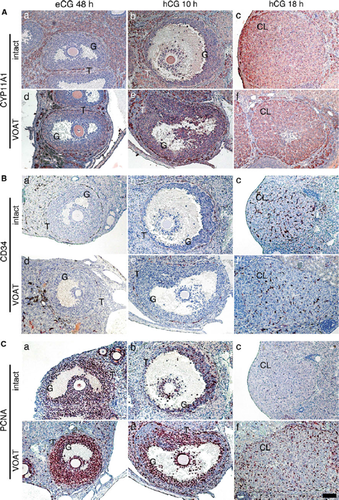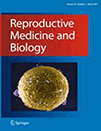Vitrified-warmed ovarian tissue autotransplantation into ovariectomized mice restores sufficient ovarian function to support full-term pregnancy
Abstract
Purpose
Our previous study demonstrated that heterotopic autotransplantation of fresh ovarian tissue followed by transfer of blastocysts supported full-term pregnancy in the mouse. In the present study, to address whether vitrified-warmed ovarian tissue has the potential to support uterine preparation for implantation and subsequent pregnancy to full term, we examined vitrified-warmed ovarian tissue autotransplantation (VOAT) in mice.
Methods
VOAT into kidney capsules was performed for sexual cycle-ceased mice after 7 days of ovariectomy. Uterine potential of decidualization was examined by oil infusion on day 4 of pseudopregnancy. Immunohistochemical analysis was performed to examine the potential in VOAT ovarian tissues. Blastocysts were transferred into uteri on day 4 of pseudopregnancy.
Results
In VOAT mice, uterine decidualization on day 8 of pseudopregnancy was the same as that in intact mice. Blastocyst transfer into the pseudopregnant VOAT mice showed the same rates of pregnancy and live birth pups as intact mice, while less steroidogenesis in the corpus luteum was detected in VOAT mice.
Conclusions
The autotransplantation of vitrified-warmed ovarian tissues after 7 days of ovariectomy restored their sexual cycle and then supported their pregnancy and production of offspring.
Introduction
Ovarian transplantation provides a broad platform of opportunities in reproductive medicine and biology. In particular, ovarian cryopreservation appears to be a potentially valuable method for fertility preservation. Because iatrogenic infertility caused by a decline in ovarian function after chemotherapy and radiotherapy is a serious problem for cancer patients [1], ovarian cryopreservation followed by re-implantation has been widely advocated [2–6]. However, the optimum technical approach is still controversial [7].
The mouse is an important animal for studies in ovarian transplantation and cryopreservation; e.g., xenografts can survive in immunodeficient host animals, such as severe combined immunodeficiency (SCID) and nude mice, which have been used to test viability after transport or cryopreservation of ovarian tissue [8]. Allograft of cryopreserved ovarian tissue into the kidney capsule of SCID mice allows the recovery of oocytes for in vitro maturation, followed by in vitro fertilization, embryo transfer, and subsequent birth of pups [9, 10].
In mice, autotransplantation of ovarian tissue has also been demonstrated. Intraperitoneally autografted fresh and vitrified ovarian tissues both contained intact primordial and primary follicles with normal morphology of stromal cells at 5 days after transplantation [11]. Our previous study demonstrated that fresh ovarian tissues that were autotransplanted underneath the kidney capsule and those autotransplanted into the subcutaneous space supported pregnancy and full-term fetal development for transferred embryos [12]. These results indicated that autotransplanted ovarian tissues maintain functional corpora lutea.
In contrast, autotransplantation of vitrified-warmed ovarian tissues underneath the kidney capsule revealed high ability of follicles at 2 weeks after transplantation in mice [13]. Furthermore, assessment of follicle survival and growth in vitrified-warmed ovarian tissues at 7 days after autotransplantation to the kidney capsule revealed increased follicular proliferation compared to control [14]. However, it is still unclear whether vitrified-warmed ovarian tissue has the potential to support uterine preparation for implantation and subsequent pregnancy to full term after the autotransplantation. To address this issue, we examined the ability of vitrified-warmed ovarian tissue autotransplantation (VOAT) to support pregnancy and full-term fetal development for transferred embryos.
Materials and methods
Animals
Mice were purchased from CLEA Japan, Inc. (Tokyo, Japan) and bred in our animal care facility. All of the experiments in the present study were conducted in compliance with the Guide for the Care and Use of Laboratory Animals published by Utsunomiya University. Three-month-old BALB/c × C57BL/6J F1 female mice were used for ovarian autotransplantation. Vasectomized 3- to 5-month-old ICR male mice were used for mating to induce pseudopregnancy.
Autotransplantation and vitrification of ovarian tissues
Autotransplantation was performed as described previously with slight modifications [12]. Briefly, ovaries were dissected into small pieces (approximately 1–2 mm wide) and all pieces were autotransplanted underneath the kidney capsules. Vitrification of ovarian tissues was performed as described previously with slight modifications [13]. In brief, dissected ovarian tissues were immersed in the equilibration solution composed of 7.5% (v/v) ethylene glycol (EG) and 7.5% (v/v) dimethyl sulfoxide (DMSO) in HEPES-buffered tissue culture medium 199 containing 20% (v/v) fetal bovine serum (mTCM-199) for 15 min, followed by the vitrification solution composed of 15% EG, 15% DMSO, and 0.5 M sucrose in mTCM-199 for 3 min at room temperature. Ovarian tissues placed on polyester sheets were submerged directly into liquid nitrogen. For warming, the polyester sheets were placed directly in a warming solution composed of 1.0 M sucrose in mTCM-199 for 1 min at room temperature. The ovarian tissues detached from the polyester sheets were transferred into dilution solution composed of 0.5 M sucrose in mTCM-199 for 3 min. After washing, the ovarian tissues were warmed to 37°C for 15 min and autotransplanted.
Exogenous hormonal treatment for VOAT
To examine the reaction for hormone priming in VOAT and intact mice, females were treated with equine chorionic gonadotropin (eCG) (5 IU), followed by injections of human chorionic gonadotropin (hCG) (5 IU) at 48 h post eCG, and then their ovarian tissues were collected at 48 h post eCG, at 10 h post hCG, or at 18 h post hCG.
Immunohistochemical analysis
To investigate the expressions and cellular distributions of CYP11A1, CD34, and PCNA, immunohistochemical analysis was performed as previously described with slight modifications [15]. CYP11A1 (also known as P450scc) is steroidogenic enzyme [16, 17]; CD34 is a marker of vascular endothelial cells [18, 19]; PCNA is a marker of cell proliferation [20, 21]. Removed ovarian tissues or ovaries were fixed in Bouin solution, then embedded in paraffin wax, and sectioned at 5 μm. Sections were deparaffinized in xylene, dehydrated in a graded ethanol series, immersed in 3% (v/v) hydrogen peroxide in methanol, treated with 10% (v/v) normal goat serum in Ca2+- and Mg2+-free Dulbecco's phosphate-buffered saline (PBS), and then incubated overnight at 4°C with primary antibodies. For the primary antibody reaction, sections were incubated with rabbit polyclonal antibody to CYP11A1 (Millipore, Billerica, MA, USA), rat monoclonal antibody to CD34 (Hycult Biotechnology, Uden, The Netherlands), or rabbit polyclonal antibody to PCNA (Santa Cruz Biotechnology, Inc., Santa Cruz, CA, USA). After washing, the sections were incubated with secondary antibodies: biotinylated goat anti-rabbit antibody (Zymed Laboratories, Inc., San Francisco, CA, USA) for CYP11A1 and PCNA and biotinylated goat anti-rat antibody (Zymed Laboratories) for CD34. After the incubation of horseradish peroxidase-conjugated streptavidin (Zymed Laboratories), the reactions were visualized using 3-amino-9-ethyl carbazole (AEC; Zymed Laboratories) as a chromogen, followed by counterstaining with hematoxylin. Reddish deposits indicate the sites of immunoreaction. Some sections were stained with hematoxylin and eosin. Images shown are representative of at least 6 sections from more than 3 different animals at each stage. The experiments were repeated at least three times.
Induction of decidualization
To examine uterine differentiation in VOAT mice, decidualization was induced as described previously [22]. Briefly, mice were mated with vasectomized males to induce pseudopregnancy (day 1 = vaginal plug). The induction of decidualization was initiated by an intraluminal infusion of sesame oil (25 μl) into one uterine horn. The contralateral horn served as an intact control. On day 8 of pseudopregnancy, the wet weights of the infused and noninfused (control) uterine horns were recorded. The fold induction in uterine wet weights was used as an index to compare decidualization in VOAT mice with that in intact mice. To perform the immunohistochemical analysis, transplanted ovarian tissues or intact ovaries were removed and fixed at the same time.
In vitro fertilization and embryo transfer
In vitro fertilization (IVF) was performed as described previously with slight modifications [12, 23]. Donors of oocytes and sperms were BALB/c × C57BL/6J F1 females and ICR males, respectively. Female mice were treated with eCG (5 IU) followed by injections of hCG (5 IU) at 48 h post eCG. Collected oocytes were used for IVF. Blastocysts at 96 h after IVF were transferred into uteri of mice on day 4 morning (9000–1000 h) of pseudopregnancy. Cesarean sections were performed to deliver live fetuses on day 19 of pregnancy (day 1 = vaginal plug).
Statistical analysis
A chi-squared test was used to evaluate differences in rates of pregnancy and birth of pups. Comparisons with expected values of <5 were analyzed using Fisher's exact probability test. An unpaired Student's t test was used to evaluate increases in uterine weight. P < 0.05 was considered to be significant.
Results
Distribution of CYP11A1, CD34, and PCNA in VOAT ovarian tissues
VOAT into the estrus cycle-ceased mice on the 7th day after ovariectomy mice recovered their estrus cycle. To address the potential of vitrified-warmed ovarian tissues, we performed morphological and immunohistochemical analysis in transplanted ovarian tissues after priming with eCG and hCG. The hematoxylin and eosin staining showed morphologically normal follicles and corpora lutea in VOAT mice (Fig. 1). Immunohistochemical analysis showed that the distribution of the steroidogenic enzyme CYP11A1 was similar between VOAT and intact, such as luteinization, granulosa cells and theca cells during exogenous hormone priming (Fig. 2A a–f). In contrast, at luteinization, CD34-positive vessel formation in VOAT mice was less than that in intact at 18 h post hCG after the injection of eCG (Fig. 2B c, f), while similar CD34-positive blood vessel densities were observed in the thecal layer of antral follicles at 48 h post eCG and at 10 h post hCG after the injection of eCG (Fig. 2B a, b, d, e). During luteinization and follicular development, higher PCNA expression was detected in luteinizing cells and granulosa cells of VOAT mice compared to intact (Fig. 2C a–f). These results indicate that steroidogenesis in the hormone-primed VOAT mice was similar to that of intact mice, while VOAT mice possessed less blood vessel formation during luteinization than intact mice.

Histological analysis of ovarian tissues after hormonal treatments. Mice were given eCG followed by hCG 48 h later. a, d 48 h post eCG. b, e 10 h post hCG. c, f 18 h post hCG. A antral follicle, CL corpus luteum, K kidney. Bar = 500 μm

Distributions of CYP11A1, CD34, and PCNA proteins on ovarian tissues after hormonal treatments. Mice were given eCG followed by hCG 48 h later. A CYP11A1. B CD34. C PCNA. a,d 48 h post eCG. b,e 10 h post hCG. c,f 18 h post hCG. Brown-red pigments show CYP11A1, CD34, and PCNA. T theca cells, G granulosa cells, CL corpus luteum. Bar = 100 μm (color figure online)
Uterine endometrial differentiation supported by VOAT
To address whether vitrified-warmed ovarian tissues support uterine function, we examined the ability of uterine decidualization during pseudopregnancy in mice with VOAT. As shown in Fig. 3A a–c, decidualization on day 8 of pseudopregnancy (caused by oil infusion on day 4) occurred in all females in both intact (9/9) and VOAT (9/9) mice. The fold increase of uterine weight in VOAT was not significantly different from that in intact mice (Fig. 3Ac). In ovarian tissues of pseudopregnant mice with decidualized uteri, the steroidogenic enzyme CYP11A1 and CD34-positive blood vessel density in the corpus luteum in VOAT were less than those in intact mice (Fig. 3B a, b, d, e). In contrast, the number of PCNA-positive cells was greater in luteal cells in VOAT than that in intact mice (Fig. 3Bc, f). These results indicate that the VOAT mice possessed sufficient potential to support endometrial cell differentiation, whereas the corpus luteum in the ovarian transplant showed decreased steroidogenesis and blood vessel formation on day 8 of pseudopregnancy.

Uterine decidualization and ovarian condition in VOAT mice. Pseudopregnant mice were given an intraluminal oil infusion into one uterine horn on day 4 to induce decidualization followed by estimation on day 8. A Decidualization in uteri of intact (a) and VOAT (b) mice. Fold increase indicates comparison of weights between infused and non-infused uterine horns (c). The results are shown as fold increase ± SEM. No significant difference in decidualization between intact and VOAT mice. Numbers above bars indicate reacted/examined mice. B Expressions of CYP11A1 (a, d), CD34 (b, e), and PCNA (c, f) in the corpus luteum in mice with a uterus show decidualization on day 8 of pseudopregnancy. a–c samples from intact mice, d–f samples from VOAT mice. Brown-red pigments show CYP11A1, CD34, and PCNA. A antral follicle, CL corpus luteum. Bar = 200 μm (color figure online)
Restoration of fertility by VOAT into estrus cycle-ceased ovariectomized mice
To examine the fertility of VOAT mice, blastocysts were transferred into the pseudopregnant females, and then the pregnancy was confirmed on the day of Cesarean section. The pregnancy rates of mice with intact ovaries (intact), transplantation of ovarian tissues without vitrification (no vitrification), VOAT within 1 h after the ovariectomy, and VOAT at 7 days after the ovariectomy were 83.3 (5/6), 100 (6/6), 80.0 (4/5), and 83.3% (5/6), respectively (Table 1). The rates of live birth pups in intact, no vitrification, VOAT within 1 h after the ovariectomy, and VOAT at 7 days after the ovariectomy were 36.7 (22/60), 27.6 (16/58), 26.0 (13/50), and 26.7% (16/60), respectively (Table 1). There were no significant differences among them. These results indicate that VOAT into estrus cycle-ceased mice restored similar fertility to achieve full-term fetal development for transferred embryos as in intact mice.
| Treatment of transplanted ovarian tissues | Timing of transplantation after ovariectomy | No. of mice examined | No. (%) of mice pregnanta | No. of embryos transferred | No. (%) of pups |
|---|---|---|---|---|---|
| Intactb | – | 6 | 5 (83.3) | 60 | 22 (36.7) |
| No vitrification | Within 1 h | 6 | 6 (100) | 58 | 16 (27.6) |
| VOAT | Within 1 h | 5 | 4 (80.0) | 50 | 13 (26.0) |
| VOAT | At day 7 | 6 | 5 (83.3) | 60 | 16 (26.7) |
- aPregnancy was evaluated on the day of Cesarean section
- bNeither ovariectomy nor transplantation
Discussion
The present study demonstrated that autotransplantation of vitrified-warmed ovarian tissues into kidney capsules after 7 days of ovariectomy restored their sexual cycle and then supported their pregnancy and production of offspring. Our results indicate that the ovarian tissues vitrified and warmed by our methods preserve functions to maintain pregnancy and full-term development.
The fertility to term in VOAT mice was not different from that in intact mice. Furthermore, when oil infusion into the uterus was performed on day 4 of pseudopregnancy, both intact and VOAT mice showed similar uterine decidualization on day 8. These results indicate that VOAT mice possess sufficient potential to support endometrial cell differentiation and proliferation during pregnancy. In contrast, in VOAT mice on day 8 of pseudopregnancy, steroidogenesis and blood vessel formation in luteal cells were less than those of intact mice, while steroidogenesis was similar during the luteinizing period in ovarian tissues between VOAT and intact mice. These results suggest that VOAT ovarian tissues function well enough to term, although the potential of VOAT ovarian tissues is less than that in intact mice at the postimplantation period during early pregnancy.
It has been reported that the ‘window’ of uterine receptivity for blastocyst implantation in mice remains open for an extended period at lower estrogen (E2) levels but rapidly closes at higher levels [24]. Furthermore, blastocysts can initiate implantation beyond the normal ‘window’ of uterine receptivity when the P4 level is appropriate [25]. Therefore, sufficient potential to support pregnancy in VOAT ovarian tissues may arise as a result of the lower estrogen level and sufficient P4 level, while steroidogenesis and blood vessel formation in the corpus luteum in VOAT mice were less than those in intact mice.
In VOAT ovarian tissues, higher PCNA expression, a marker of cell proliferation, was observed compared with intact ovaries. It has been reported that PCNA-positive follicles after cryopreservation and 7-day autotransplantation were significantly increased, including the antral stage, in the ovarian tissues compared with control tissue [14]. Similar increases in follicular growth after cryopreservation and transplantation of ovine cortical tissue were observed [26]. Therefore, it is hypothesized that the ovary under physiological conditions is dominated by inhibitory mechanisms, which are no longer available during transplantation [14, 26]. Our results also showed that VOAT mice had higher PCNA expression than intact mice. This accelerated proliferation of vitrified-warmed ovarian tissue could be associated with viability of ovarian tissues followed by the function to support uterine differentiation and the birth of offspring.
In the present study, we found that VOAT into the kidney capsules recovered ovarian functions to support pregnancy to term. However, the rate of live birth pups in VOAT mice was likely to be less than in intact mice. Our results also showed that steroidogenesis and blood vessel formation in the corpus luteum in VOAT mice were less than those in intact mice. Since it is well known that optimal levels of ovarian steroids are key regulators of uterine receptivity, improved steroidogenesis may increase the production of pups, although further study of hormonal function in VOAT ovarian tissues is necessary.
Acknowledgments
We thank Noriko Numata for expert technical assistance.




